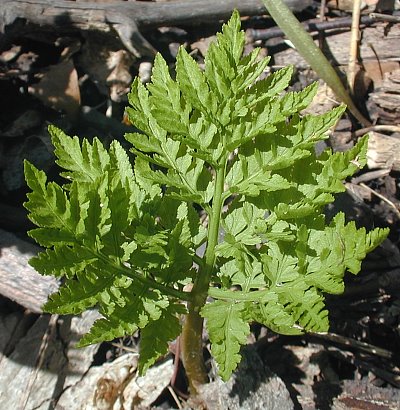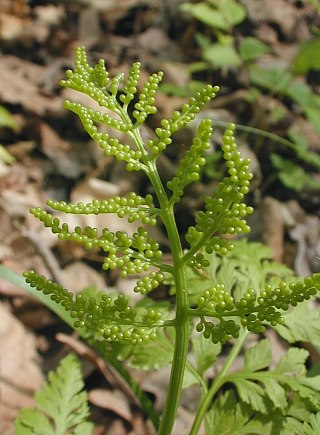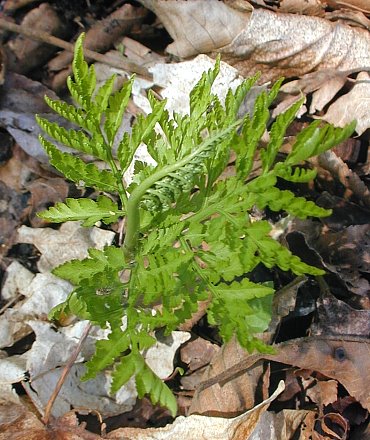
The stalk of the fertile leaf is 3-6" long, light green, terete, slightly succulent, and glabrous. At its apex, there is a glabrous fertile leaf about 3-6" long and about one-half as much across; its structure is bipinnate to pinnate. The leaflets and subleaflets are stalk-like in shape with sessile sporangia (spore-boring structures) along their sides; they are initially light green, but become brown at maturity. Individual sporangia are globoid in shape and 1 mm. across or less; they are initially light green, but become yellow and finally brown when their spores are released. A fertile leaf begins to develop before the sterile leaf has fully unfolded during the late spring. Spores are released from the fertile leaf during the summer. They are distributed by the wind. The root system is fibrous and fleshy. Occasionally, clonal offsets are produced.

Cultivation: The preference is partial sun to light shade, mesic to dry-mesic conditions, and a fertile loamy soil with an abundance of decaying organic matter. Generally, this fern is nearly impossible to cultivate from spores, which form underground gametophytes (the sexual life stage of ferns) that lack chlorophyll and take several years to develop. Their survival is dependent on the presence of appropriate mycorrhizal fungi in the soil. After this life stage is complete, a fern will begin to produce above-ground leaves (the sporophytic life stage). This fern is also difficult to propagate by division of its root system, and a transplanted fern usually fails to thrive at its new site. As a result of these difficulties, Rattlesnake Fern is rarely available for purposes of cultivation.
Range & Habitat: The native Rattlesnake Fern has been found in every county of Illinois and it is relatively common (see Distribution Map). Habitats include rich mesic to dry-mesic woodlands, wooded slopes, upland savannas, open disturbed woodlands, and areas along paths in wooded areas. This fern is also found in moist woodlands in areas that are well-drained. It is often found in woodlands that are dominated by oaks (Quercus spp.) and hickories (Carya spp.), sometimes colonizing areas with a history of disturbance.
Faunal Associations: Very little is known about floral-faunal relationships for Rattlesnake Fern. Sometimes evergreen ferns in this genus are browsed by the Ruffed Grouse, Wild Turkey, and White-Tailed Deer, but this usually happens during the winter when little else is available. However, in contrast to other species of its genus in North America, Rattlesnake Fern is deciduous, rather than evergreen.
Photographic Location: Along a wooded slope and a woodland path in east-central Illinois. The photographs were taken during late spring.

Comments: This is the largest and most common fern of its genus in Illinois. It can be identified by its sessile sterile leaf, which often appears to be 3 leaves. This sessile characteristic becomes apparent whenever a fertile leaf is produced from a stalk that originates from the base of the sterile leaf. In other species of this genus, the sterile leaf has a true petiole that diverges from the stalk of the fertile leaf. Ferns in the Adder's Tongue family (Ophioglossaceae) are considered to be relatively primitive when compared to ferns in other families. This partly because their gametophytes lack chlorophyll – a trait that they share with many club mosses, which are among the earliest vascular plants to appear on Earth.